

6 Engineering Site Visit Checklist Tips to Know
An engineering site visit checklist is critical for most projects. It’s the reality check that keeps designs grounded in the real world.
Site visits are the ultimate way to get up close and personal with a project and the client. You’ll usually find yourself making site visits during these project stages:
- Project kickoff to grasp the work scope
- Design phase to fine-tune project details
- Construction phase to tackle problems
- Start-up post-construction to ensure everything’s running smoothly
To make the most of each site visit, follow my 6 engineering site visit checklist tips. I’ll focus on design phase visits, but these takeaways apply to all stages. Also, enjoy some rad photos from a hydroelectric facility I helped retrofit.
#1 Map out a solid plan of action for your site visit
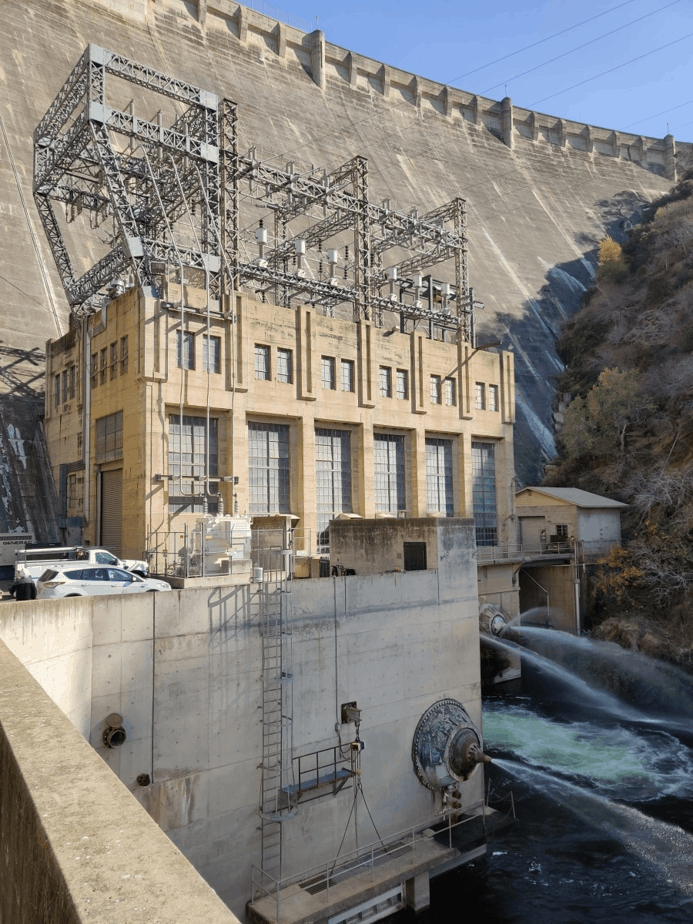
Preparation is the name of the game. Before I set foot on a site, I know exactly what I need to do there.
Take this example: say my project is to upgrade an existing substation for increased capacity. I’d first make a list of questions for the client and items to investigate at the site.
Client questions might include:
- Do you have existing as-built drawings and specs?
- How much new load are you forecasting?
- Can you break down the existing loads?
- Are there any issues I should know about?
- Is any existing equipment causing trouble?
- How much space is there to expand the substation?
- What’s your lead time for this project?
- How much downtime can you handle during the cutover phase?
- Are other upgrades needed (e.g., security, protective relaying)?
My site investigation checklist would include:
- Confirm equipment ratings
- Measure clearances
- Snap photos inside panels (e.g., control panels)
- Inspect existing equipment (e.g., switchgear, transformers)
- Measure space for new equipment
- Check transmission and distribution line connections
- Look for facility quirks or safety concerns
Keep in mind, I might tackle some tasks over the phone or through email before the visit. This way, the client can gear up for our powwow and avoid wasting precious time.
For instance, there have been times when I forgot to mention that I needed to inspect panel X. At the site, the client told me they couldn’t access it.
Come prepared to keep site visits efficient
When you visit a site, your client will most likely show you around. You won’t have all the time in the world to explore and brainstorm on the fly. Besides, you don’t want to come across as a clueless, unprepared engineer.
So, treat a site visit like any other high-stakes meeting. Some site visits can take months to arrange, so it’s best to know exactly what you want to achieve before you even set foot on the site. You don’t want to return from the visit kicking yourself, thinking,
“DAMN! I forgot to take photos of the control panel’s interior!”

Important Note: Don’t forget to ask your client about any site safety concerns. This is crucial for your safety and everyone around you.
I’ve been to sites with live 230,000-volt equipment and experienced treacherous drives to sites where I’ve nearly met my maker .
#2 Investigate the site thoroughly
Time to channel your inner Sherlock Holmes! Your blueprint for this detective work is the action plan you create in tip #1.
You’ll want to check if the client’s scope of work has any limitations, or if there are other issues your client forgot to mention. Sometimes, the work scope seems straightforward on paper, but once you’re on site, you uncover a whole slew of unexpected problems.
I like to compare it to our ambition to travel and colonize Mars. From Earth, the mission appears simple: send a couple of big rockets to Mars and create an artificial habitat that provides oxygen and protection from extreme cold, high radiation, and low atmospheric pressure.
However, the reality is mind-blowing. The challenges are enormous, and there’s a never-ending list of problems we haven’t even considered yet. Just take a look at some of the issues I’ve listed here when it comes to tunneling on Mars alone.
The point is, don’t just rely on what your client tells you. You’re the expert, so it’s up to you to investigate the site and determine what’s best for your client. After that, you can discuss your findings with them and fine-tune the work scope.
#3 Snap loads of pictures at the site

Nowadays, everyone has a high-end camera in their pocket with their smartphone. You can take endless top-quality photos on a whim. But, you need to know how to take great photos at a project site too.
Otherwise, when you return to your office, your photos might only cause more confusion. To avoid this, I’ll share four tips on how to take and manage pictures (and videos) effectively.
A) Organize and separate your photos on site
Picture yourself at a project site, snapping away photos, feeling like you’ve got everything under control. You think you’ll remember why and where each shot was taken. But let’s be real, once you’re back in your office, it’s a hot mess trying to figure out which photos belong where.
Imagine taking 50 pictures at location A and another 50 at locations B and C. To keep things organized, I whip out my trusty notepad, jot down the location or equipment, and snap a photo of it. Here are some examples of what I write:
- Inside building X looking at the west wall
- Inside the left-most cabinet of switchgear ‘Faulk’
- Investigating high voltage cabling of switchgear ‘Faulk’
With my digital divider in place, I only then start snapping field photos. Once I’m done, I move on to the next spot and repeat the process. Trust me, this technique is a lifesaver when you’re dealing with hundreds of photos.
B) Take photos in a patterned consistent manner
So, you want to capture the components in a 90-inch tall control panel? First, step back and get an overall shot of the panel. Then, zoom in and snap photos of the components from top to bottom.
This way, you can easily understand the mounting arrangement of the components in the zoomed-in photos. I’ve had moments where I didn’t take zoomed-out photos, and back in the office, it was a nightmare trying to follow the wiring of the components. Super frustrating!
C) Upload and organize your photos ASAP
Get those photos uploaded and organized right after your site visit, while everything’s still fresh in your head. If you missed any of the earlier photo tips, you’ll remember the details and make a note.
Next, turn each of your written notes from photo tip ‘A’ into separate folders. For example, if you took pictures at three different spots on your project site, your digital file organization would look something like this:
Main folder: Site Visit at Zeus Substation (DD/MM/YY)
Subfolders:
- Location #1
- Location #2
- Location #3
Lastly, give each of your photos a detailed name. Invest a little time now, and you’ll save yourself from future headaches.
D) Take a lot of photos
Back in the day, film was expensive, so you had to be stingy with your shots. But now, there’s no reason not to go photo-crazy! Plus, you can review the quality of each photo right there on the spot.
So go ahead, take loads of photos and even videos. They’ll only help you back at the office. I say, if a photo has even a 1% chance of being useful, take the shot! You never know when those seemingly pointless pics might save the day.
#4 Bring all your necessary supplies to the site
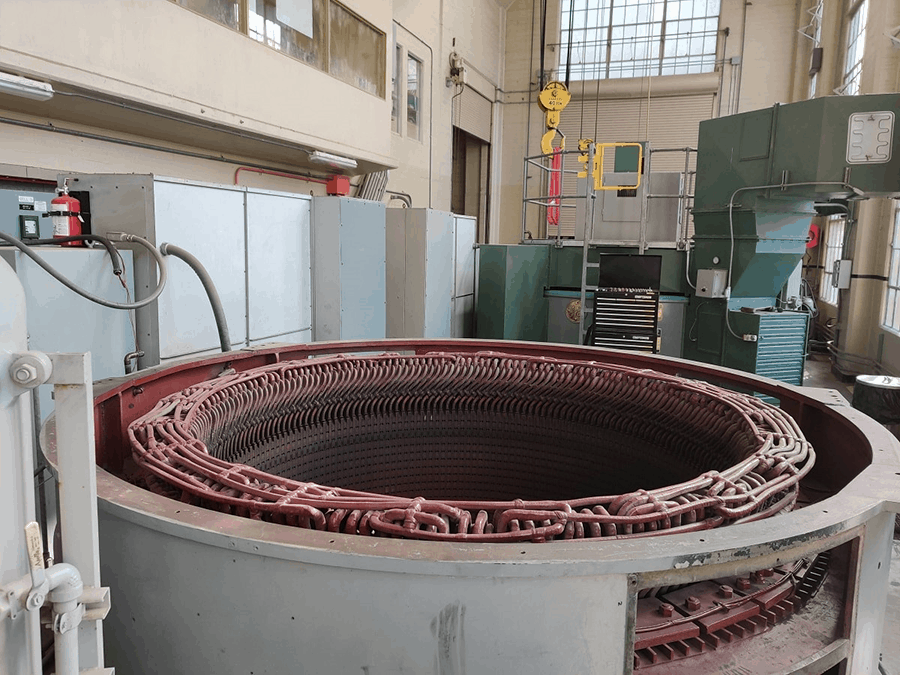
Depending on your field of engineering, you’ll have a bunch of supplies to bring along. My list is always pretty lengthy . Don’t expect your client to hook you up with supplies, especially since they’re paying you!
So pack for the unexpected and bring all your gear just in case. You never know when you’ll need to measure a piece of equipment or pry open a panel. If you’re not prepared, you’ll miss out on valuable data.
#5 Forge a strong connection with your client during site visits
Nothing beats getting to know your client face-to-face, right? Sure, digital communication is a breeze these days, with everyone clutching their trusty smartphones.
But, let’s be real – in-person interactions still reign supreme. That’s why I think site visits are the perfect chance to bond with your client.
Without a face to match the name, you’re just another entry on their spreadsheet. Genuine human connections, on the other hand, pave the way for deeper relationships. This usually leads to smoother project execution. Plus, your future requests are less likely to be left hanging.
#6 Show up on time for your site visit
This one’s a no-brainer, but punctuality is key. Actually, aim to be 10 to 15 minutes early. You don’t want to make a lousy impression by keeping your client waiting.
Go the extra mile to pinpoint the precise site location in advance. This might mean asking your client for map snapshots and off-the-beaten-path directions. After all, some engineering project sites can be in the boonies, with no physical address that your GPS can easily locate.
I’d recommend downloading the site map on your phone, just in case you lose signal. Alternatively, use a non-internet-dependent GPS device.
And if you’re running late, give your client a heads-up with a phone call. At the end of the day, professionalism is paramount.
Engineering site visit checklist wrap up
Site visits play a huge role in engineering projects. The better you tackle site visits, the more successful projects you’ll spearhead.
My advice? Learn about site visits specific to your engineering field . Pick the brains of seasoned engineers to discover what to look for during site visits. Then, tweak your engineering site visit checklist as needed. You might uncover something unique to your line of work that I didn’t cover.
What do you find the most important about engineering project site visits? What’s on your engineering site visit checklist?
SUBSCRIBE TO ENGINEER CALCS NEWSLETTER
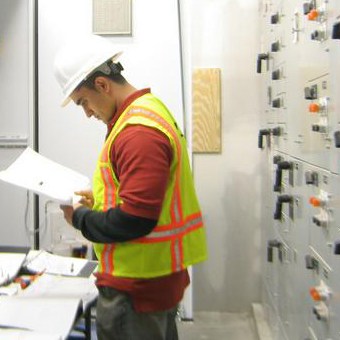
Author Bio: Koosha started Engineer Calcs in 2019 to help people better understand the engineering and construction industry, and to discuss various science and engineering-related topics to make people think. He has been working in the engineering and tech industry in California for well over 15 years now and is a licensed professional electrical engineer, and also has various entrepreneurial pursuits.
Koosha has an extensive background in the design and specification of electrical systems with areas of expertise including power generation, transmission, distribution, instrumentation and controls, and water distribution and pumping as well as alternative energy (wind, solar, geothermal, and storage).
Koosha is most interested in engineering innovations, the cosmos, sports, fitness, and our history and future.
Leave a Comment Cancel reply
Save my name, email, and website in this browser for the next time I comment.

Free Site Analysis Checklist
Every design project begins with site analysis … start it with confidence for free!
Site Visit Analysis and Report: How to conduct and evaluate your first architecture site visit
- Updated: January 2, 2024

Here we will cover everything you need to know about of how to approach your first site visit analysis for a new project, what to do when physically there, and how to eventuate and summarize the information you collect.
However before visiting for the first time we highly recommend that you carry out desktop study beforehand, as this will provide an important initial understanding of the site and generate far better results and more refined questions once there.
The desktop study will also help to identify the important items of equipment that you will need to take with you to make your trip as successful as possible. …these are mentioned below but may include a:
- Site map (very important)
- Tape measure
- Laser distance meter
…more essential architects items here

Conducting an architecture site visit analysis
A site visit analysis is a comprehensive report that summarizes the findings of a physical inspection of a potential development site. It includes information on the site’s physical characteristics, location, surrounding area, demographic information, environmental impact, zoning regulations, traffic flow, and recommendations for development.
The report synthesizes all gathered information to provide a comprehensive understanding of the site and its potential.
What to look for?
Once there, there are a whole number of important areas and items that need to be studied and recorded, some of which would have already been identified during your desktop study, but as a starting point we’ve produced the below list of all the key areas:
We suggest that you take these with you and tick them off as they are found, so not to miss anything.
- Entrance and access points (both pedestrian and vehicle)
- Security (gates, surveillance)
- Travelling to the site (road types and suitability, safety, public transport)
- Boundary treatment (fencing, vegetation, land form, water)
- Extent of boundary (does it match the survey/OS map)
- Circulation (existing travel routes within the site)
- Noise levels (quiet and loud areas)
- Services (electric, gas, water, sewage)
- Existing buildings (condition? Relevant? Protected?)
- Existing landscape features (condition? Relevant? Protected?)
- Neighbouring buildings (local vernacular, protected?)
- Views in and out of the site (areas to screen off and areas to draw attention to)
- Tree’s and vegetation (protected and rare species)
- Ecology (any areas likely to be home to protected species)
- Orientation (sun and wind paths)
- Light levels (areas in direct sunlight, shaded areas, dappled light)
- Accessibility (disability access)
- Surrounding context (historical, heritage, conservation area, SSSI, AONB)
- Existing materials in and around the site
- Topography (site levels)
- Flood level (is it likely to flood)
- Soil and ground conditions (types and suitability)
- Existing legal agreements (where are the rights of way, covenants)
- Hazards (Electricity lines, Drainage, Telephone lines, Sub-stations)
We provide a site analysis checklist here covering all of the above that’s free to download.

Where to start
You want to begin documenting your visit as soon as you arrive, as the approach and entrance to your site are just as important as the site itself. If you’re desktop study didn’t highlight the possible routes and methods of transport to and from the site, then this needs to be recorded also.
Documenting your first impressions is vitally important, ask yourself; what do you see as you enter the site? what do you hear? what do you feel? (…what senses are the first to be triggered), you will only get one chance to do this properly and so you need to make it count!
…and don’t forget to include the location of the elements you record, when noting it down on your site map or survey. By the end of your visit, you should barley be able to read whats under all your notes …write down everything!
Moving on from first impressions, you should plan to walk around the site as least twice (as a minimum) to ensure that nothing is missed, so leave enough time to make a least two loops, noting down and photographing everything that you feel is relevant, no matter how small.
…there’s nothing worse than getting back to the studio and realizing you forgot to document something.
We like to use the check list supplied above and:
- Firstly walk around the site whilst annotating a site plan
- Secondly with a camera …photographing everything
- and thirdly with both …just in case something has been missed
This way we can focus on one task at a time, helping to ensure we gather everything we need.
In terms of a camera, and depending on your budget we suggest looking one these three options (but a phone is just as good):
- Sony DSCW800 Digital Compact Camera
- Sony DSCWX350 Digital Compact Camera
- Canon EOS 1300D DSLR Camera
It can be difficult to identify certain elements, and some may only be noticeable from a professional survey, such as underground services and precise spot levels. But approximations of such locations and heights are a good start and can serve as a reminder for further investigation.
If accessible you can of course take your own measurements and so this is where a tape measure and/or distance meter will come in handy.
Try one of these:
– Tape measure
– Laser distance meter
What to take with you
Firstly look at the weather, you wont have a good time if your not dressed appropriately, and this applies to protecting your notes and equipment as well as yourself.
…a simple quick check, can make or break a visit, arranging to go on sunny day will also give you the best site photographs, which could also be used in future CGI’s and presentation material.
If the site is derelict, or has potentially dangerous or hazardous elements, it is likely that you will require personal protection equipment (otherwise known as PPE) so make sure this is organised before setting off.
As a minimum you want to take with you a camera, a pen and an OS map. Google Maps can provide a temporary (though very basic) version, but a much preferred scaled version that can normally be obtained through your university or practice via such companies as:
- Digimap – digimap.edina.ac.uk
- Xero CAD – xerocad.co.uk
- CAD Mapper – cadm a pper.com (free account available)
As mentioned, you will want to make notes, and record everything you observe, experience and hear all over this map. So print out a couple of copies at a usable and convenient size.

A camera is essential in documenting the site, and the pictures taken during your visit are likely to be used on a daily basis throughout your project. So once again make sure you document and record everything.
Pictures should be taken from all distances, close zoomed-in sections of materials and textures along with shots of the site from a distance to include the area as a whole and within its context.
Note pads are important for obvious reasons, we prefer an A5 sized pad, as this is much easier to carry and hold than an A4 one.
Tape measures can be useful, but we never go on a site visit without a distance meter.
…and lastly if you’re visiting on your own, don’t forget to tell someone where you’ll be and take your phone with a charged battery.
Our site visit equipment check list looks something like this:
- Weather check
- Print out our “what to look for” checklist
- Site map (at least 2 copies)
- PPE equipment
- Scale ruler
If you are interested in trying our architecture site analysis symbols for your own site analysis recordings and presentation, then head over to our shop ( Here ).
FAQ’s about site visit analysis
What is included in a site analysis.
As discussed above, site analysis typically includes the following elements:
- Site location and context: Understanding the location of the site in relation to the surrounding area, including climate, topography, neighboring buildings, and accessibility.
- Physical characteristics: Examining the site’s physical features, such as its size, shape, soil type, vegetation, and water sources.
- Utilities and infrastructure: Assessing the availability of utilities such as electricity, water, gas, and sewer, as well as the infrastructure, such as roads and transportation.
- Environmental considerations: Analyzing the site’s potential environmental impact and assessing any potential hazards, such as flooding or soil stability.
- Zoning and land-use regulations: Reviewing the local zoning and land-use regulations to determine the types of uses and development allowed on the site.
- Cultural and historical context: Examining the cultural and historical significance of the site and its surrounding area.
- Demographic information: Analyzing the demographic information of the surrounding area, including population, income, and age.
- Traffic and pedestrian flow: Studying the flow of vehicular and pedestrian traffic in the area to understand the impact on the site.
This information is used to inform the design of a building or development project, taking into account the unique characteristics and constraints of the site.
What are the steps of site analysis?
including the above, the steps involved in conducting a site analysis report typically include:
- Data Collection: Gather data and information about the site, including maps, aerial photos, zoning regulations, environmental reports, and other relevant documents.
- Site Observations: Conduct a site visit to observe and document the site’s physical and environmental conditions, such as topography, vegetation, water sources, and neighboring buildings.
- Context Analysis: Analyze the site’s location and context, including its surrounding area, access to transportation, and cultural and historical significance.
- Demographic Analysis: Study the demographic information of the surrounding area, including population, income, and age, to understand the potential market for the development project.
- Traffic and Pedestrian Flow Analysis: Study the flow of vehicular and pedestrian traffic in the area to understand the impact on the site.
- Synthesis: Synthesize the information gathered in the previous steps to develop a comprehensive understanding of the site and its potential.
- Recommendations: Based on the analysis, make recommendations for the development of the site, taking into account the unique characteristics and constraints of the site.
These steps help architects and planners to gain a deeper understanding of the site and to make informed decisions about the design and development of a building or project.
Every design project begins with site analysis … start it with confidence for free!.
Leave a Reply Cancel reply
You must be logged in to post a comment.
As seen on:

Providing a general introduction and overview into the subject, and life as a student and professional.
Study aid for both students and young architects, offering tutorials, tips, guides and resources.
Information and resources addressing the professional architectural environment and industry.
- Concept Design Skills
- Portfolio Creation
- Meet The Team
Where can we send the Checklist?
By entering your email address, you agree to receive emails from archisoup. We’ll respect your privacy, and you can unsubscribe anytime.

+256-782-930-341
Office Hours:
Monday - Saturday

Construction site visit
- Post published: 11/03/2022
- Post category: Real Estate Development
- Post comments: 0 Comments
- Post last modified: 11/03/2022
- Reading time: 5 mins read
Construction site visits are an important part of the construction process. The purpose of the site visit is to take a look at the site, assess any potential problems, and provide feedback on the work that has been done.

The following are some reasons for conducting a construction site visit:
– To assess any potential problems with the work already completed
– To provide feedback on work done so far
– To determine if there are any unforeseen obstacles or issues that need to be addressed
A site visit is a visit to a construction site. Site visits are usually conducted by clients, architects, and other stakeholders before the project is complete.
Site visits can be done in person or virtually using 3D models or video.
Site visits are often used to review construction progress, identify potential risks and hazards, and confirm that the work is being done according to the design specifications.
In order for a site visit to be successful, it is important that all parties involved have an understanding of what they will be looking for during their visit and what information they will need from each other.
The following questions should be discussed before a site visit:
-What are the objectives of the site visit? -What inspection methods might we use onsite? -How will we
Site visits are a great way to learn more about the construction process.
You may have heard that site visits are a great way to learn more about the construction process. But what is it like to visit a construction site?
A site visit is an opportunity for you to see how your home or business will be built. You’ll get a chance to see how work is progressing and ask questions. It’s also an opportunity for you to meet with your builder and architect, who can answer any questions you might have about the project and its progress.
The best part of visiting a construction site is that it gives you an idea of what it will be like when your home or business is finished and it’s ready for occupancy.
A site visit is a meeting or inspection of a building site by an engineer, architect, or other consultant. The purpose of the site visit is to verify that the construction is progressing according to plan and to assess any risks, including potential hazards and safety issues.
A site visit usually involves:
– Assessing the progress of construction work against the design drawings
– Verifying compliance with building codes
– Identifying risks and making recommendations for remedial action
– Conducting inspections for safety purposes http://8-must-dos-in-scheduling-construction-site-visits/
Site visits are a great way to get first-hand insights on how the project is progressing.
It is traditionally assumed that site visits involve going to sites and examining them for defects, workmanship, materials and equipment, and that if the conditions are not satisfactory, requiring corrective action by the site managers. This can be for one reason or another.
Site managers who receive inspection visits must be prepared to schedule them accordingly with appropriate supervision, unless they are scheduled out of consultation with sufficient lead time from senior management.
Site visits are a very important part of construction. The way a site visit is carried out depends on what type of building is being built or constructed.
Site visits are typically carried out to survey the construction progress, to make sure all the required materials needed for the process are in order, and most importantly to make sure that everything is being done as planned.
If there were no site visits, it would be difficult for contractors and clients to know if any obstacles had arisen, or if mistakes were made by either party during construction. Site visits also help detect functionality issues and design error. Furthermore, a lot of times site staff lawyers will not allow prospective tenants or buyers who desire to visit the building enter on their own before inspection has been made by either one of the parties (property owner).
A construction site visit is classified as “an inspection of a construction project carried out with a view to establishing facts such as the progress of works, materials on site, and equipment’s as well as identifying hazards or problems in order to decide what might be done better or differently
Construction site visit to happen at least once per shift
1 out of 5 construction workers report that their site visits don’t happen often enough
One major challenge with a construction site visit is that it identifies hazards and risks but does not provide viable solutions. The root cause may have caused from lack of maintenance or improper installation.
A thorough investigation must always be performed before safety remedies are put in place and workers subjected to any danger. https://gotinoconstruction.com/construction-site/
You Might Also Like

How can I start a construction business with no money
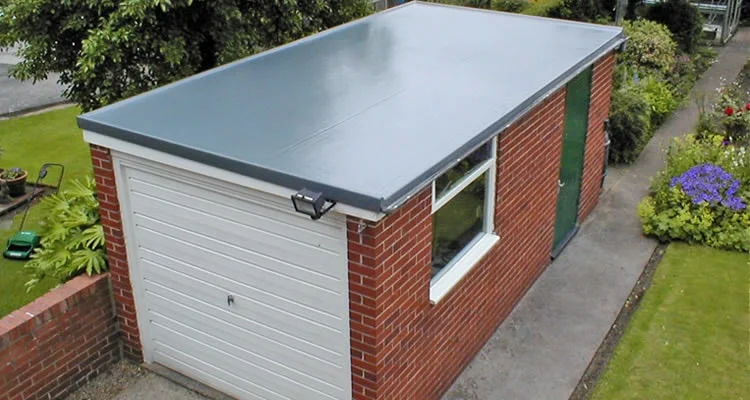
Get the Most for Your Home Improvement Dollars with the Right Company!
Leave a reply cancel reply.
Save my name, email, and website in this browser for the next time I comment.
Useful Links
Corporate locations.
Plot number 481 and Block number:98, Nsambwe, Mukono
Lira Branch:
Odokomit behind Totco-Ober Road
+256-782-930-341 or +256-700-395-162
Privacy Overview
Terms of Service - Privacy Policy

Owner Approach
Focused on owner’s requirements, Conspectus offers an accurate, transparent view of how decisions made during the design process will ultimately impact project cost, construction quality, and building operations.
Services
- Systems & Performance Descriptions
- Risk & Quality Advisory
- Guide and Master Specifications
- Decision-Management & Spec Tool
- Educational Courses
- White Papers

Architect Approach
Focused on architect's requirements, Conspectus offers an accurate, transparent view of how decisions made during the design process will ultimately impact project cost, construction quality, and building operations.
- Constructions Specifications
- Guide and Master Specs

Design-Builder Approach
Focused on design-builder's requirements, Conspectus offers an accurate, transparent view of how decisions made during the design process will ultimately impact project cost, construction quality, and building operations.

Construction Manager Approach
Focused on construction manager's requirements, Conspectus offers an accurate, transparent view of how decisions made during the design process will ultimately impact project cost, construction quality, and building operations.

Column Headline
To observe or to inspect, that is the question..
Being the son of a brick mason, I was always fascinated with construction sites. Some may disagree, but as an Architect, one of best parts of the job was visiting the site to observe the Work and interact with the Contractors. This month, as part of a look into the " Construction Alliance " and the " Construction Guidelines " , we travel to the construction site with the Design Professional to see just what they do. " Project Visits and Observations ", done properly give the Owner confidence that the design is being properly executed.
Why observation?
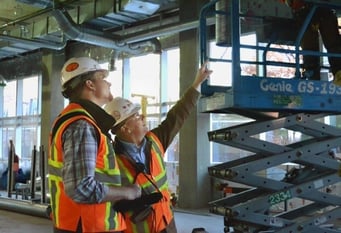
As part of the basic services, the Design Professional is required to visit the jobsite and become generally familiar with the progress of the Work. The site observation allows them to be confident that the Contractor is following the Contract Documents and reassures the Owner that the Work in place conforms to the intent of the documents. Inspection on the other hand implies a higher level of observation and can be provided to the Owner as an additional service.
How often do project visits occur?
Well that depends! If it is a large or complex project, the Design Professionals may have a daily presence on the site. Medium to large projects may require weekly or bi-weekly visits, whereas smaller projects can get by with a visit once a month. At a minimum, the site should be visited monthly in coordination with the pay application. With regular communication with the Contractor, the Design Professional can better coordinate and make timely visits.
What is the purpose?
The purpose, first and foremost, is to verify general conformance or compliance to the Contract Documents. If there is a deficiency, or some work that is deficient, the Design Professional should issue a notification of non-conformance or non-compliance and the Contractor will correct the deficiency. At the same time, the site visit is a perfect opportunity to assist the Contractor in interpreting or resolving conflicts with the Documents while being able to see the issue.
Finally, the Design Professional should make an estimate of the amount of completed work which goes hand in glove with the payment application. Refer to the " Progress Payments " guideline for additional information.
Document, document, document! After the site visit, a field report should be made and distributed to the Owner and the Contractor. The report should contain the observations which were made, including weather conditions, estimates of completed work, any non-conforming work, and general observations which would assist the Owner, Contractor, and Design Professionals. Sometimes photographs taken are included, depending on the professionals office policy, some encourage them, some don't.
What about safety?
Let's make one thing perfectly clear, I'm a big advocate for job site safety and personal protective equipment. I have firsthand experience with family members being injured on jobsites and have seen many news stories about accidents at project sites. It is clear that the Contractor is responsible for site safety, so as a visitor to the job site, the Design Professional MUST comply with the Contractor's safety protocols. Some Contractor's safety protocols are more stringent than others. It is often said that Design Professionals should not comment on safety, this is true. However, while on the job site you notice something that provides an imminent threat to life or safety, you should bring it to the attention of the Superintendent.
Final thoughts!
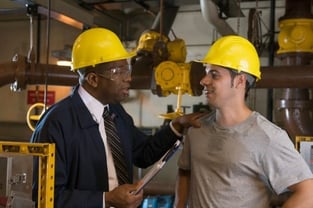
Speaking as an Architect, when I visit a jobsite, I check my ego at the door. Yes, I may have been involved in the production of the Contract Documents and I may know a thing or two about construction and how we (Design Professionals) think it should go together. BUT, I don't build it, others do. They have the experience I don’t have. They may know a better more economical way to put something together which improves the quality of the Work and provides the Owner with a better overall project. I learn a lot when I go to a jobsite and ask the Superintendent to explain something, or if they ask me a question, I would often ask them for their opinion, then go back to the office before making a decision.
Please make certain to read the guideline " Project Visits and Observations ", and if you have any comments, please let me know. I'd love to hear your thoughts. Next month join me as we discuss the " Punch List ".
Till next month…
Steve Gantner RA, CSI, AGCMO, SCIP, CCS, CCCA
Senior Specifier - Conspectus, Inc.

- Availability
- What is an Appraisal?
- What is Market Value?
- Typical Appraisal Process
- Testimonials
- Request A Quote
INSPECTION or SITE VISIT
The term inspection typically refers to the site visit with respect to the appraisal process. The inspection or site visit can have different steps and/or levels depending upon the scope of work of the engagement.
Typical residential site visit types include:
- Interior and Exterior inspection
- Exterior only inspection
- No inspection (desktop products/reports)
An Interior and Exterior site visit process for a typical residential property (single family, condominium, townhouse, multi-family, etc.) includes:
- Inspection of site and site features
- Inspection of exterior features of site improvements
- Measurement of site improvements (exterior measurement is industry standard)
- Inspection of interior of site improvements (detailed walk-through, interior components, floor plan, photographs, etc.)
An Exterior only inspection process can include all of the above mentioned components excluding any interior inspection of improvements. Many exterior only inspections are done from the street. This is typical when permission to access the property is not requested or provided.
No inspection is just that, no site visit. Knowledge and research from sources such as the county property appraiser website, local multiple listing service (MLS), proprietary products (fee or membership database products), aerial maps, satellite imagery, internet sources, etc. are utilized in this and all inspection formats.
The level of detail or observation in any appraisal inspection or site visit is constrained to what is readily observable . This is defined as ‘ observations made by the appraiser of conditions that are immediately discernible and noticeable during the typical site visit. The appraiser is not required to move furniture, equipment, or cause damage to the property. ’ (HUD definition)
Preparation for the site visit
A point worth mention, an appraiser must be state licensed to perform appraisals in the State of Florida. You can verify any state license or certification through the Department of Business and Professional Regulation (DBPR) website: http://www.myfloridalicense.com/dbpr/ . You will need the name and/or license information to verify.
To facilitate the site visit, it’s beneficial but not a requirement to have this information ready for the appraiser:
- A plot plan or survey of the house and land (if readily available)
- Home inspection reports, or other recent reports for termites, septic systems and wells
- List of major home improvements and upgrades, the date of their installation and their cost (for example, the addition of central air conditioning or roof repairs) and permit confirmation (if available)
- Information on “Homeowners Associations” or condominium covenants and fees.
- Accessibility: Make sure that all areas of the home are accessible, including the attic and crawl space
- Housekeeping: This is not an element of comparison within the appraisal report. That being said, the impression of maintenance and upkeep can have a qualitative affect.
- Maintenance: Repair minor things if possible.
- You should be available to answer questions about your property and be willing to point out any home improvements.
Other beneficial documents/information includes:
- Information on the latest purchase of the property in the last three years
- Written property agreements, such as a maintenance agreement for a shared driveway
- List of any personal property to be sold with the home
- Title policy that describes encroachments or easements
- Most recent real estate tax bill and or legal description of the property
- A copy of the current listing agreement and broker’s data sheet and Purchase Agreement if a sale is “pending”.
- A list of “Proposed” improvements if the property is to be appraised “As Complete”.
Share This Story, Choose Your Platform!
About the author: futurehome.
Related Posts
Typical appraisal process, what is market value, what is an appraisal.

The Ultimate Site Visit Checklist For Emcees & Event Planners
A staggering 98% of event planners have hosted or will host at least one in-person event in 2023. 85% have planned to host upwards of three in-person events.
However, putting together an entertaining, memorable, and lively event isn’t always as easy as it seems. And if you want to host a successful function, you need to be sure that you start off on the right foot.
Key takeaways
- A site inspection checklist is essential for ensuring the venue you pick has all you need
- Be sure to arrive at your visit with your team and a good camera
- Each event is unique, so be sure that your checklist is personalized
- Include general information about the venue and other items regarding things like food and beverages and general safety
Site inspections are critical in ensuring the venue you picked is up to your standards. Your soon-to-be guests deserve to spend their evening at the right venue!
Keep reading, and I’ll share with you the ultimate site inspection checklist that will help you organize the perfect conference, meeting, or event.
See Related: What Is A Run Of Show And Do I Need One As An Emcee?
Why is it important to have a site inspection checklist?
The thing about great events is that they’re made to look easy. Whenever guests arrive, they likely won’t notice all the fine details and painstaking effort that went into making the magic happen.
However, if you’re a speaker or an event planner, you need to always be on top of your game. There’s actually a lot that goes into organizing a great function, and you can’t let anything slip through the cracks!
Finding a location for your event is an essential part of the event planning process
For any event, you need to be sure you find a suitable venue . Not every location is going to have what you need. And you need to be totally aware of your desires before going into this.
That’s why the event planning process in and of itself is so essential. It’s the backbone of a successful evening. You can’t expect great results without taking the necessary time to prepare and plan!
After finding a prospective venue(s), be sure to conduct a site inspection
Hopefully, you spent plenty of time scouting out prospective venues online. You’ll need to set aside a good chunk of your event planning energy for just research.
But, before booking a venue , you need to conduct a site visit . This is the only way you can be sure if you found the perfect event venue.
Four essential tips to keep in mind when completing a SITE inspection
Site visits help you ensure that every detail of your prospective venue falls into line with what you are looking for. And though this can seem like a pretty straightforward deal at first, there’s actually a lot that you’ll need to pay attention to.
Before we dive into the more intricate aspects of site inspection checklists, let me give you a few general tips when going on a site visit with the acronym SITE : Sense, Inquire, Teamwork, and Expectations.
#1 – S: Sense
One of the things that will truly save you during any site inspection is your gut. You have to listen to what your heart tells you!
Let’s say that a certain venue has all the specific features that you want, but it doesn’t have that overall vibe you’re looking for. You shouldn’t settle , and you should take into consideration how a place makes you feel because that feeling will extend to your guests.
#2 – I: Inquire
When you go on a site visit, you’ll likely be meeting with a group of people or a team. You’ll also likely be in contact with the people you will be renting from.
Now is the time to ask all the questions that might be irking you . Even the smallest inquiry should be voiced!
However, be smart about the questions you ask and the time you ask them . Be sure that whatever you ask isn’t already answered on any materials you may have.
#3 – T: Teamwork
Take time to connect with other event planners before conducting your site inspection. In most cases, your visit will involve a group of people, anyway.
Talk to as many other planners as you can, especially if they’re already involved in your specific event, conference, or meeting. Then, after the inspection, you can exchange ideas and points of view before moving forward.
This type of teamwork is essential in ensuring you pick the right venue!
#4 – E: Expectations
Preparation and planning are key when it comes to planning an event . I doubt I can say that enough!
So, before arriving at your site inspection, come prepared . That’s what site inspection checklists are for, and they’ll surely save you in the end.
Bonus: 6 Motivational Themes To Include At Your Next Corporate Event
What you should consider before heading to any site inspections
I think I need to say it again. Before heading to your site, get prepared. You can’t ever over-prepare!
To start with, you need to always bring your own unique site inspection checklist. This helps you ensure that the venue you’re looking at checks off all your boxes (literally.)
However, that’s not all that you should focus on. Here are a few more things you should do before setting a date to check out the site.
- Check in with your team , and be sure that everyone is on the same page. Take into consideration any recommendations or requests they might have.
- Pack plenty of tools that you might need , including the basics, like a camera with a backup battery and plenty of free storage space.
- Research the surrounding area as well as the specifics of the venue itself. Read any available resources like online virtual floorplans or brochures to make sure you know what you’re getting yourself into.
- Prepare some business cards to give out to the sales rep of the venue when you show up to help network.
- Keep in mind the things you really need to see at the venue. If you’re not interested in the pool area, it might be worthwhile to gloss over this during the visit.
Now, let’s get into what your site inspection checklist should have on it.
Everything you should include on your site inspection checklist
As an experienced corporate emcee , I’ve been a part of plenty of site visits. Any great master of ceremonies knows that they need to be involved in all parts of the event planning process!
So, without further ado, let me give you a comprehensive breakdown of a well-rounded site inspection checklist.
Keep in mind that this can vary from event to event . Each event is unique, and you should pay attention to your specific needs. If you are interested in something that’s not on this list, add it in!
- The date and time of the site inspection appointment
- The name, address, and contact information for the venue
- The availability of the venue
- General safety info, including fire protection guidelines
- Nearest airport and general directions
- Nearest hotels and general directions, price breakdown, and amenities
- Parking areas and applicable fees
- Directional signage Food and beverage
- Breakfast, whether it’s continental or full
- Lunch and dinner
- Coffee and other beverages
- Service charges, tax rates, and special packages
- Be sure to also inquire about the general quality and selection of the food and beverages themselves
Audio and visual
- What equipment is provided in-house, including the quality and availability
- Rental rates and labor rates
- Consider if union rules are applicable and with what requirements
Meeting rooms
- Space availability
- Charges for rental rooms or set-up
- Soundproofing, decor, and general cleanliness
- Sound system and presentation equipment
Any extra details
Don’t hesitate to add in any other details you might want to consider. There’s so much that can go into this!
Wrapping up
Hosting a great event doesn’t need to be a challenge or an uphill battle. With a great site inspection checklist in your back pocket, you’ll be able to pick out the perfect venue and establish the basis for a killer function!
Keep Reading: 9 Corporate Event Themes Your Team Will Love
Adam Christing has been called “ The Tom Brady of emcees .” He has hosted more than 1,000 company meetings, special events, gala celebrations , and more. He is the author of several books and founder of CleanComedians.com . For more event tips, follow Adam Christing on Instagram , Facebook , Pinterest , LinkedIn , and YouTube .

Recent Blog Posts:
Adam christing, america’s most popular corporate emcee and clean comedian, appears on the wow factor podcast, 7 ways to make your end-of-year staff meeting memorable and meaningful, the importance of force majeure clauses when corporate hosting.
- 5 Stage Presence Tips From A Master of Ceremonies
- Master of Ceremonies Helps 10 Non-Profit Groups Raise Over $77 Million at 10 Fundraising Events in the Fall of 2023
- The Difference Between Hosting B2B and B2C Events
- 5 Games To Enhance Your Next Annual Company Dinner
- 5 Ways To Make Your Workplace Festivities Inclusive During The Holidays
- 5 Holiday Fundraising Ideas From A Corporate Emcee
- What Is B2B Event Planning? Your Complete Guide
Recommended For You
Comments are closed.
- Get Started
- Event Emcee
- Entertainment
- How To Be A Great Emcee
Subscribe to Adam's newsletter
Laughing Matters
Powered by Big Red Jelly
Connect with Adam:
© 2024 Adam Christing. All Rights Reserved. Privacy Policy . Terms & Conditions .
- EASY BOOKING FORM
- Bureaus and Offices
- Contact HRSA
Site Visit Protocols and Guides
Health center program site visit protocol (svp).
The Site Visit Protocol is a tool to assist the Health Resources and Services Administration (HRSA) perform its oversight of health centers. The SVP includes a standard and transparent methodology that aligns with the Health Center Program Compliance Manual .
Health Center Controlled Network (HCCN) Site Visit Guide
The Health Center Controlled Network (HCCN) Site Visit Guide (PDF - 449 KB) provides an overview of the site visit process and activities to complete in preparation for and completion of a site visit for both consultant and HCCN.
- Awardees: HCCN Awardee Presentation Slides (PDF - 852 KB)
National Training and Technical Assistance Partners (NTTAP) Site Visit Guide
The NTTAP Site Visit Guide (PDF - 799 KB) includes all the information that organizations need to prepare for the completion of site visits.
- Awardees: NTTAP Awardee Recording | NTTAP Awardee Presentation Slides (PDF - 387 KB)
Primary Care Association (PCA) Site Visit Guide
The PCA Site Visit Guide (PDF - 943 KB) includes the information that organizations need to prepare for the completion of site visits.
- Awardees: PCA Awardee Recording | PCA Awardee Presentation Slides (PDF - 422 KB)
Federal Tort Claims Act (FTCA) Site Visit Protocol
The Federal Tort Claims Act (FTCA) Site Visit Protocol streamlines site visits to ensure compliance with the FTCA deeming requirements found in 42 U.S.C. 233(h) and (q). FTCA site visits are distinct from Health Center Program Operational Site Visits (OSVs) under section 330 of the Public Health Service Act. FTCA site visits enable HRSA to assess FTCA deeming requirements and provide technical assistance to health centers.
Conducting a site inspection checklist
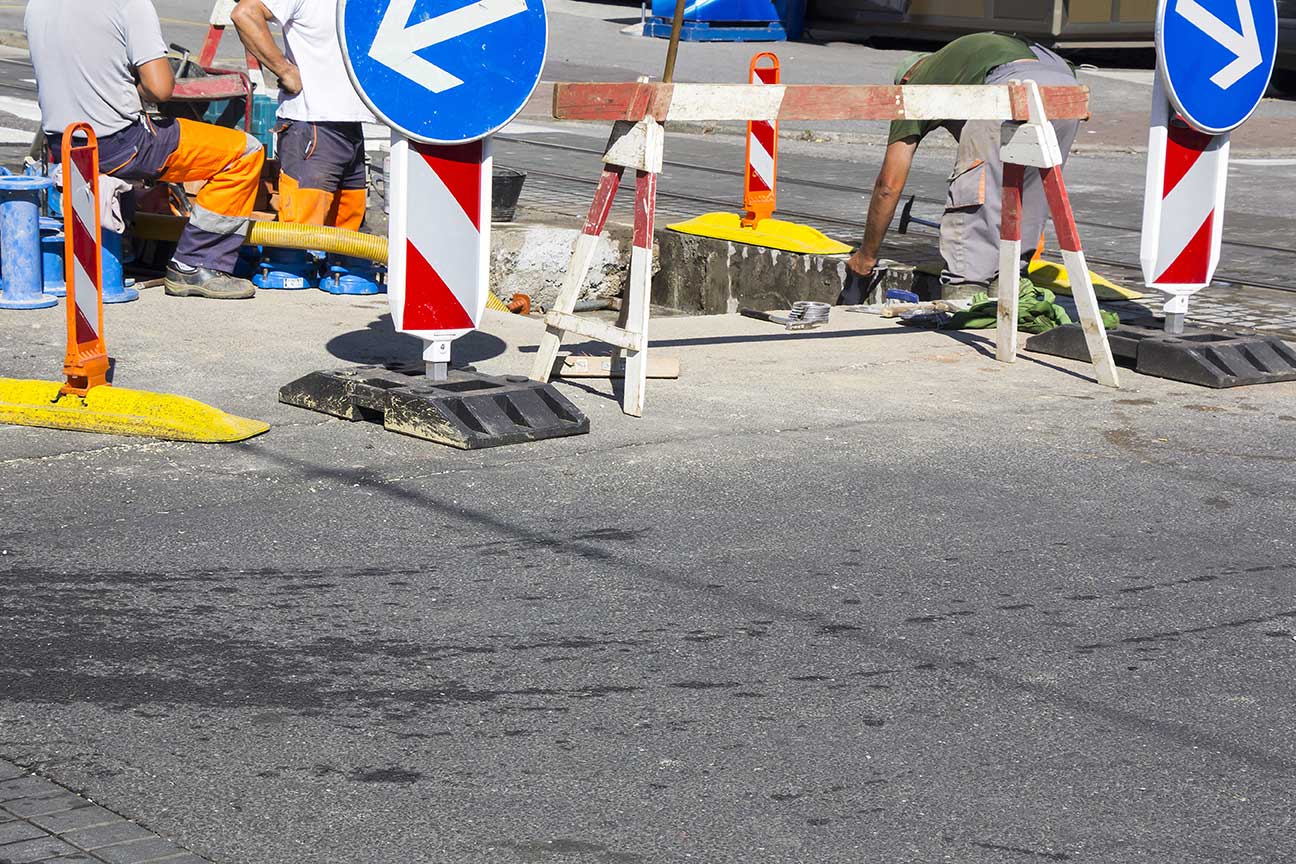
How to do your site inspections and site inspection checklist more efficiently
What is a site inspection checklist.
Site inspection checklists are one of the most powerful tools construction and industrial companies have for keeping their people, sites and assets safe and working properly.
Sites are inherently dangerous places, harbouring heavy machinery and equipment, lots of moving pieces, and countless people. In order to manage sites and all of these moving pieces before disaster strikes and it's 'too late', we have proactive measures that are taken and documented frequently in order to try prevent these issues arising in the first place.
One such measure is the site inspection and site inspection checklist.
A site inspection forces a person or people to check and inspect a specific phase of work, equipment, machine or item - and provide a base level of assurance that it is in correct working order and as it should be.
The best and most reliable method we have for performing a site inspection is the site inspection checklist - where we check off a of set items which we know to be important in that work or the functioning of that item in order to deem it safe or 'okay'.
The purpose of a site inspection checklist is multi-faceted. The main reason for them is to keep people safe and work moving forward properly, but there are some other positive outcomes which stem from conducting site inspections properly which include:
- Entering data into checklists manually
- Accountability when something goes wrong. If a machine breaks down or someone gets injured in an avoidable accident, people can look back at the checklist and understand who's job it was to check that (where applicable)
- Inspectors and auditors who arrive on your sites will find bulletproof inspection records
- By conducting checklists, people find minor problems and issues which can be rectified before they become larger issues and blowouts which cost more time, effort and money
- People are more likely to take care and being more cognisant of what they are doing in the knowledge that it will be inspected
So if we all agree that site inspections are important and beneficial, how can we conduct and manage site inspections and site inspection checklists more efficiently to optimise our time and be in a position to best action the findings and insights derived from site inspections?
How are site inspections managed today?
To date, site inspections have been managed without modern technologies and softwares. Many companies today still use word documents, excel spreadsheets, PDFs and paper-based forms to create, manage and track their site inspections.
While this does 'work', it saps and wastes a lot of resource and engineering time - with people having to spend decent portions of their work days:
- Downloading, uploading and emailing checklists back and forth
- Formatting word documents into PDFs and vice versa
- Reconciling the information captured on site in spreadsheets and CSVs
- Manipulating this data into charts and graphs to discover insights about site inspections
Because site inspections have been performed like this for so long, people have become accustom to doing work like this - but there is a better way today.
How to capture your site inspection checklist more efficiently
Modern technology has made it far more efficient to capture, organise and track your site inspection checklists. In addition to speed, Site inspection software is also bringing new clarity and insight to site inspections by aggregating and processing all that checklist information quickly.
These new efficiencies start at the source of the document.
Instead of completing a site inspection on a piece of paper, word doc or spreadsheet, these softwares make it possible to complete the inspection inside of that software.
This gives you a number of advantages and improved efficiencies over and above traditional documents:
- You can complete site inspection checklists on any device, and the checklists were designed and formatted for each of those specific devices including mobile, tablet and computer
- These forms have smart logic which guides people through the process and streamlines the form to only feature questions which need to be asked and answered
- When forms are 'completed', the information is automatically pushed into the cloud where it is automatically organised and stored securely (so it can't get lost etc.)
- You can take photos, videos and markup PDFs and drawings to support the inspection being conducted, and these items are attached to the inspections to keep all of your important information together
- You can clone digital forms and signoff on forms digitally, saving time and improving record keeping
- Checklists have versioning control and audit trails making them immune to tampering and other issues
These are just a few of the benefits which are 'available' to those using digital inspection tools.
People are so used to using their mobile devices and the experience is so much easier that it also increase inspection participation and decrease the changes of pencil whipping or the tick and flick - where people just flow through the checklist without paying attention and it becomes a pointless exercise.
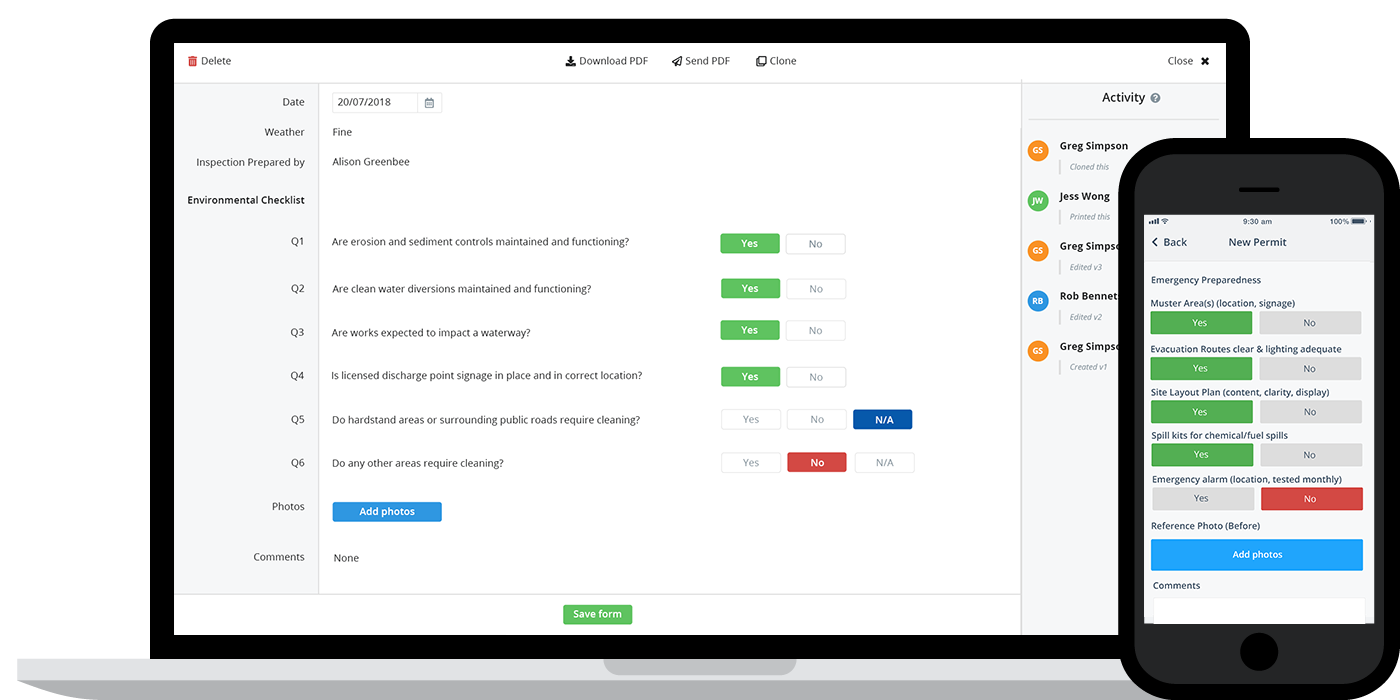
Getting paper-based records out of the cloud when you need them
Some companies worry about going digital because of the way their processes are setup today, and how they manage their checklists and documents.
But most softwares cater to both the digital and analog worlds well. It's easy to manage site inspection checklists digitally - from start to finish - and then print out, download or share a checklist record when required.
You can see an example of this below.
The weekly safety inspection checklist has been captured and managed in the software, until it has needed to be printed.
Every checklist which is downloaded, printed or shared comes attached with a company logo and branding, giving you professional looking records and reducing the paper trail which stems from managing checklist manually from beginning to end.
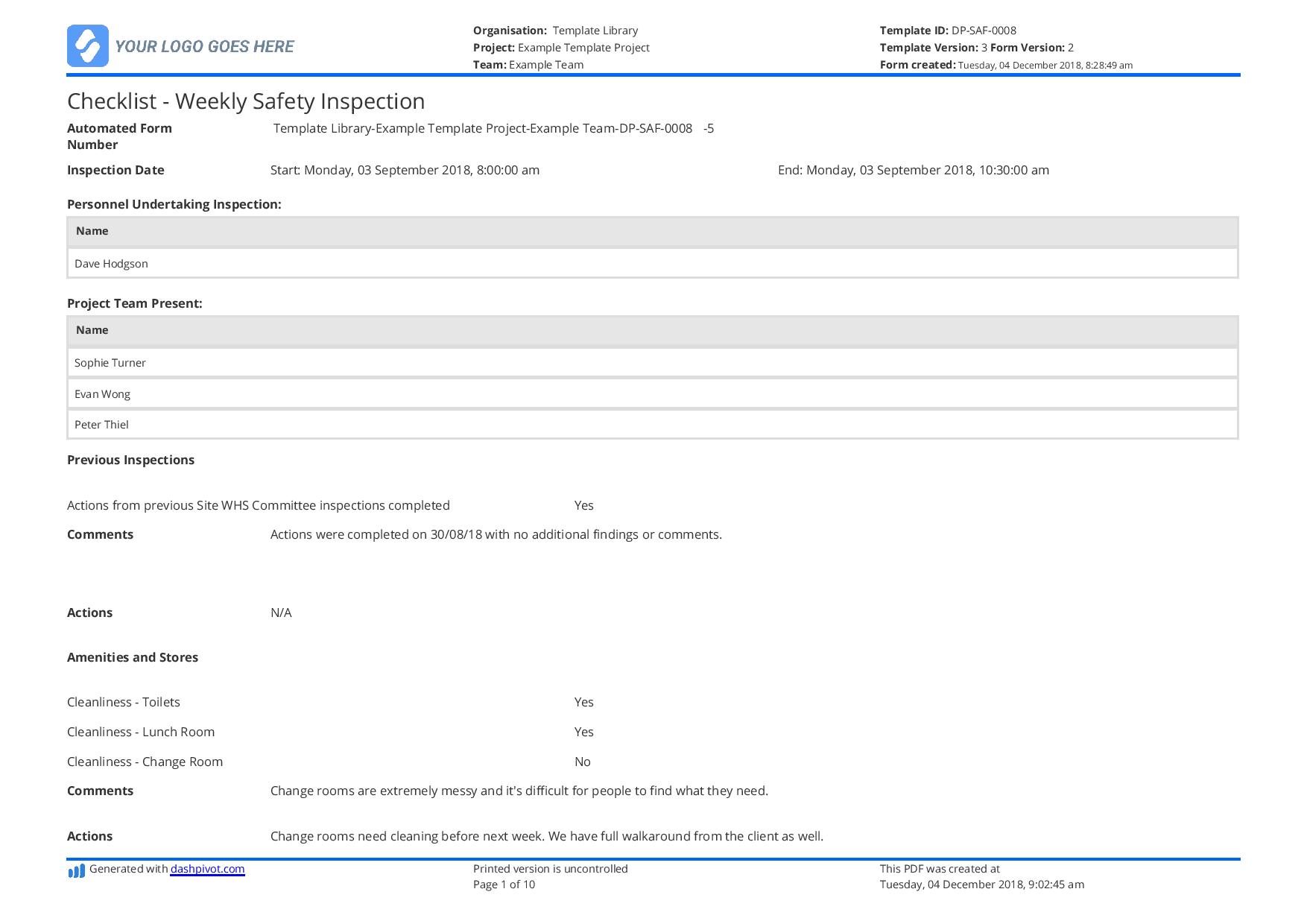
Try a smart and digital site inspection checklist for free now.
How to organise and track all of these site inspections effectively.
The other major benefit of software, as we eluded to before, is in its ability to 'crunch the numbers' quickly and efficiently.
Instead of having a bunch of trained engineers, project managers and administrators combining data from a bunch of checklists, software can combine and aggregate data automatically.
This information can then be displayed in dashboards and charts - which can be pivoted and toggled with ease. In addition, these analytics being pulled from site inspections are being shown in real-time, meaning you are seeing exactly what's happening when it happens.
You can see how many inspections have been completed; see how many checklists certain teams or individuals have completed; and see the status and outcomes of these inspections and more.
This enables companies and projects to be even more proactive in spotting trends preventing issues before they arise - giving people the power and control to make better decisions - as well as to hold people accountable for the way they perform and manage those all important site inspections.
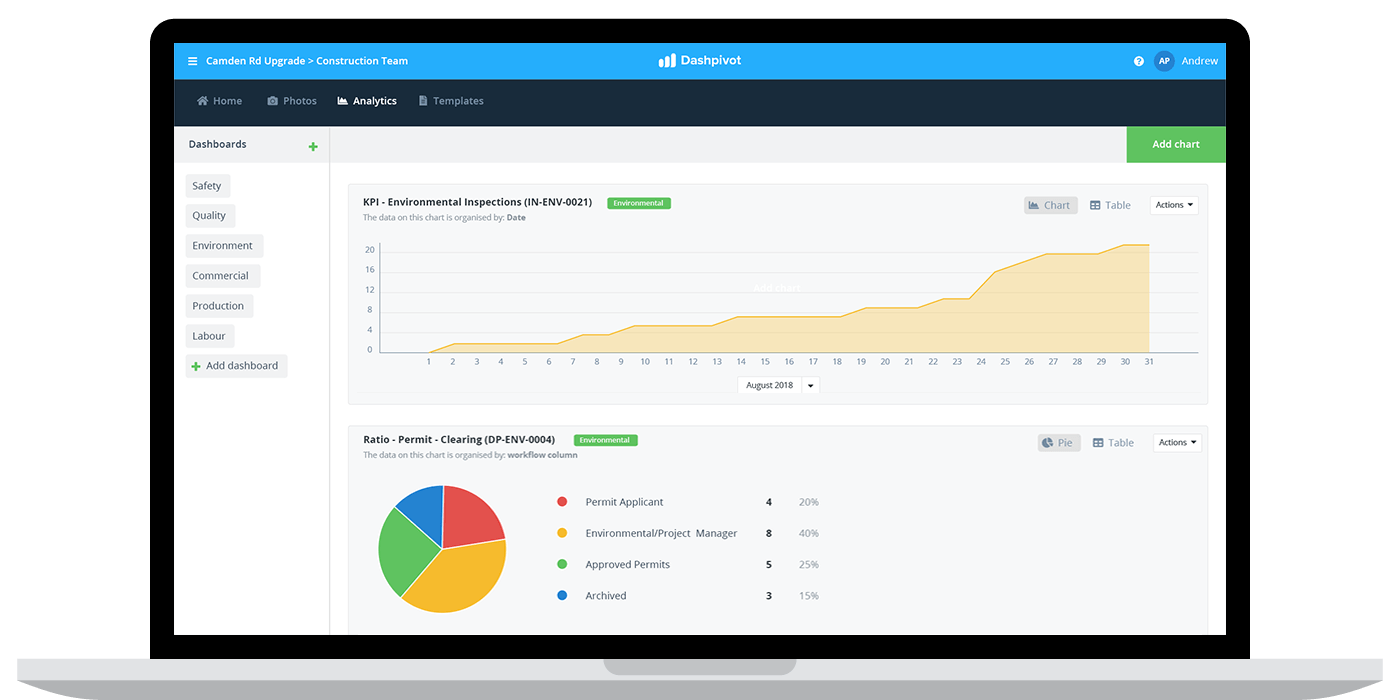
Digitising one checklist or going completely paperless
The transition to new tools and technologies can be a hard one, and its best when it is staged or managed gradually. The great thing about site inspections and site inspection checklists is that it's easy to test and trail the new technologies.
You can experiment with a digital form for safety or quality inspections, and gather feedback from your teams as to how it's been going.
While a paperless future will likely arrive at some point, it's worth investing the time and effort today to begin building the efficiencies which are inherent in managing your site inspection checklists with software - rather than manual methods.
You can try a couple of our site inspection checklists below for free, or learn more about the software here if you are interested in streamlining all of your site inspections (as well as some other 'jobs').

Site Inspection template
See the template →
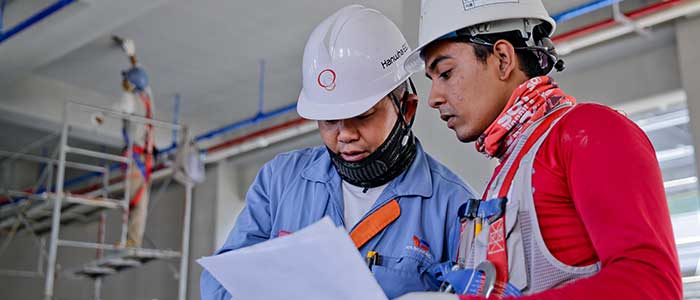
Weekly safety inspection checklist template
See how you can easily streamline your systems and processes with sitemate today.
About Lance Hodgson
Lance is VP of Marketing at Sitemate. His aim is to bring awareness to a brighter future for the Built World where industrial workers and companies work smarter.
As a building inspector, this checklist is very helpful for my team safety and use your checklist for my next project.
Thank you and have a nice day 🙂
Leave a Comment Cancel Reply
Save my name, email, and website in this browser for the next time I comment.

A site inspection checklist is a tool event planners can use when visiting a location they’re considering for their next affair.
Examining a venue in person allows you to make note of the advantages and limitations of what’s available. Having a checklist makes it easy to keep track of all the little details. This way, you can make an educated decision either way. It also helps to have this info handy when you begin planning the event.
Get every detail right at any site with accurate diagrams
Get Started Free
A site inspection checklist helps event planners remember every little detail, no matter how small, when visiting a venue. It also helps to keep uniform records of site inspections as a future reference for both yourself and other team members.
Organized and extremely detailed records like these are a huge asset to event planners, regardless of whether they ultimately choose the venue this time around.
In an ideal world, you’d schedule your site inspection a year out from your event, with follow-up visits six months and one month out.
But the new norm seems to be a single visit just a few months away from the event. Not to worry though ” a site inspection checklist is a great tool for this situation since it helps to make sure you get all your ducks in a row in just one visit.
A site inspection checklist helps event planners remember every detail, no matter how small, when visiting a venue. Click To Tweet
2. Scheduling
Event planners can typically schedule a site inspection through a sales representative at the property via phone or email. If it’s a hotel, they might also coordinate your complimentary room at this stage, although not all sites offer free rooms with every inspection.
3. Preparation
Conducting a site visit requires time management skills from both the planner and the venue itself. Make sure you’re prepared with your site visit checklist and preliminary research completed before you arrive. And if the visit feels rushed, make a note of that as well.

3 site inspection tips
- Ask smart questions. Ask questions that can’t be answered by any materials you already have. Also, remember to time your questions well. Some questions are better to ask during a tour, while others are more suited to ask during a break.
- Connect with at least three other event planners. Most often, a site visit will involve a group of people. Talk to as many event planners as you can and exchange contact info. After the inspection, you can connect and discuss your points of view about the venue and whether you’ll each move forward with it. They might even have some insider info to pass along.
- Have a checklist ready to go. As we’ve already mentioned, having a checklist with you is one of the most important steps to a successful site inspection. Use our checklist as a jumping-off point and be sure to include additional questions of your own.
Try the world’s most popular event diagramming
In addition to bringing a checklist like the one below, you’ll also need to do each of the following:
- Research, research, research. Look at specifics about the venue and the surrounding area. Review all resources (like virtual tours and downloadable floor plans) the venue provides ahead of time.
- Check in with your team . Go over your inspection checklist to see if they have any further recommendations or requests for you.
- Prepare business cards . You can give them to the venue’s sales rep and other tour members for networking purposes.
- Pack the right tools. You should always bring a camera (that has plenty of available storage) with at least one backup battery just in case. Also, remember to take your checklist and an organized list of your event needs and wants.
- Know what you need to see and what you don’t need to see. If the gym and pool areas aren’t necessary for your guests, make sure your contact at the venue knows that ahead of time. Be sure to have a must see list and kindly insist on visiting these areas during the visit.
Remember, the point of the site inspection is to leave with all the info you need to make a decision about the venue. So prepare accordingly. In addition to this list, you can also prepare by getting to know what separates a good inspection from a bad one.

Hotels and other event venues should do their best to impress event planners during site inspections. But there are some telltale signs that a venue is going truly above and beyond (or not).
Here are some signs that the site knows how to lead a quality site inspection:
- They are honest about hidden costs or availability. The sales rep should tell you about pricing options and fees upfront.
- They ask for event specifics before you arrive . Venue reps should already be familiar with your event needs and how they can accommodate them ” even if they have to get a little creative to do so.
- They provide full access to updated and accurate floor plans . To-scale floor plans are a must for event planners, and venues should go out of their way to make sure you have them so you can successfully plan table layouts .
- They don’t overpromise. If the venue isn’t able to fulfill things like food and beverage requests or equipment availability, they should be transparent about that. They should also provide all the possible alternatives they have on hand.
- They provide a custom, tailored experience for your visit. Their site inspection agenda, room set-ups, and walk-throughs should all mirror your event vision.
- They give you a single point of contact. Having one team member you can contact before, during, and after the site visit makes it easier to communicate with the venue.
Once you know these telltale signs, it’s time to prepare your own checklist.
Bring your checklist to life faster with easy diagramming
Get Started Now
- Site inspection date
- Contact information
- Venue availability
Site specifics
- Mobil rating
- Is there any upcoming construction planned? If so, when?
- Is the venue ADA compliant? If no, why not?
- Cancelation policy
- Attrition penalty
- Deposit amount and due date
- Neighborhood
- Building appearance
- Landscaping
Event logistics
- Nearest airport & distance from venue
- Nearest hotel (if venue is not a hotel) & distance from venue
- Parking fees
- Valet parking availability
- Freeway accessibility
- Directional signage
- Recreational services available
Food & beverage
- Continental breakfast
- Full breakfast
- Coffee (per gallon)
- Service charge
- Guarantees needed by
- Overset guarantee by (%)
- Special packages
- Presentation
Audio & visual
- Equipment provided
- Equipment quality
- Equipment availability
- Rental rates
- Labor rates
- Are union rules applicable? If so, what are the requirements?
Additional checklist items for meeting rooms
- Space availability
- Room rental charge
- Set-up charges
- Cleanliness
- Soundproofing
- Ceiling height
- Temperature control
- Sound system
- Presentation equipment
- Number of elevators and proximity to space
- Nearest restroom proximity
- Nearest restroom cleanliness
- Catering availability
Additional checklist items for hotels
- Is complimentary transportation to/from the nearest hotel and/or airport available?
- Approximate taxi fare from the nearest hotel and/or airport
- Total number of sleeping rooms
- Total number of suites
- Rooms with king beds
- Rooms with queen beds
- Rooms with 2 double beds
- Rooms with twin beds
- % non-smoking rooms
- Rack rate for singles, doubles, and suites
- Group rate for singles, doubles, and suites
- Complimentary rooms available
- Plus over and above
- Room tax rate
- Additional tax per room per night, if applicable
- Room block by day (list each date and corresponding number of rooms)
- Cut off date
- Are rates available after cut off date?
- Proximity to meeting space
- Cleanliness & appearance
- Square footage of each room type
- General amenities
- Bathroom conditions & cleanliness
- Is there a workspace or desk available inside rooms?
- Is there a sitting area available inside rooms?
- Number of restaurants in hotel
- Number of lounges in hotel
- Public restroom proximity
- Public restroom cleanliness
- Fire safety
- Handicap accessibility

5 important questions to ask at every site inspection
There are certain questions that, regardless of what type of venue you visit, are required for any event. Here are 5 questions that should give you greater insight into what the site can provide:
- How late can events run?
- What is the max capacity for each room?
- What permits are required for events?
- Are there designated areas for storage, green rooms, and/or back-of-house?
- What branding opportunities are available inside and outside of the venue?
If you want to make the most of your site visit, you must also think ahead to what you’ll need to do once it’s over. Make sure to address each of the following:
- Review your visit with key stakeholders by forwarding them a summary of your findings along with a meeting request.
- Hold an in-person meeting to go over details, share your site inspection checklist, and answer any questions your team might have.
- Make a decision on whether or not to move forward on this venue together.
You can find even more amazing tips for site inspections and event planning with our free event planning checklist .

Final thoughts
Checking out a new venue for the first time means managing a lot of moving parts with a site inspection checklist. It also means trusting your gut and picking a venue that aligns with your event goals. Knowledge is power for the modern event planner. So be sure to include any other questions you may have that are specific to your event or your location needs. Now that you’ve read the site visit guide , check out tips for how to negotiate event contracts.
Bring amazing events to life, no stress
- Free Planner Tools
- Event Seating Software
- Event Check-In Software
Venue Tools
- Event Diagramming Software
- Interactive Floor Plans
- Photo-Realistic 3D
- Lead Capture Tools
- Event Planning
- Guides & Webinars
- Customer Stories
- Contact Sales: +1 (877) 973-2863
- About Cvent
- Cvent Community
- Help & Support
- Training & Certification
- Status & Uptime
- Terms of Service
- Privacy Policy
- Your Privacy Choices
- +1 (877) 973-2863 - Option 1
- [email protected]

Copyright 2024 Cvent Inc. All rights reserved.

Why conduct a site visit – The value of meaningful site inspections

- November 28, 2017
- Meetings and Business Events Industry , Sales and Service
When considering possible venues to host a meeting or conference, one of the best tools in the planner’s toolbox for making the most informed decision are in-person site visits of the properties. Even if a planner is familiar with the property from other events they may have attended there, walking through the space through the eyes of a particular meeting allows them to map out everything they need as a conference planner, and everything their delegates will need when they come to your hotel.
Here are some things the planners are looking for when viewing a hotel or venue:
Meeting space
- Where is the general session room in relations to guest room elevators, breakout rooms and their conference registration area?
- How about elevator access and stair access? Are there enough to accommodate your group?
- Is there wheelchair accessibility? Are all function spaces accessible?
- Are there adequate washrooms nearby?
- What is the ceiling height? Does the planner need a certain height for exhibits and/or rigging points for AV set up?
- Is it pillar free space? If not, will the pillars impede the flow of their program?
- Is there natural light in any of the meeting spaces?
- What competing groups are potentially in house over your planner’s conference dates?
- Is there a business centre onsite, or a Staples nearby for “last minute conference planner needs”?
Pre/post conference and after hours mingling
- If the planner’s delegates will be doing some “after hours” networking, are there places to do so? Lobby bar? Nearby restaurants and pubs?
- Does the hotel have a hospitality suite suitable for the group?
Amenities and outlets
- Is there an onsite coffee shop for a quick morning stop?
- Is there a pool/spa/fitness centre onsite?
- Are there nearby tourist attractions?
Guest rooms
- Do the rooms have coffee makers? Tea kettles?
- Is there wired or wireless internet? What cost, if any?
- Are there any green initiatives in place (ie towel saving program, recycling in room?)
- Are there suites for VIPs?
- Is the bathroom counter space adequate?
- Does the room have a bathtub, or shower only?
Travel and location
- Are most of your planner’s delegates coming from out of town? Are you located near major highways or airports? Parking?
- Is it easy to access during peak hours?
- What are the nearest airports and highways?
No doubt, a site visit can make or break the decision to book a certain hotel for a program. The hotel salesperson’s presentation may be the deciding factor in which they fall if there are properties very similar to each other on the shortlist.
What can a salesperson do to set their property apart from the others during a site visit?
- Know the client’s program; study their agenda before the planner arrives so you understand their needs without fumbling for papers and proposals
- Know alternatives – if something in the planner’s agenda isn’t quite the perfect fit for the property, propose alternatives before the planner has to ask for them. Exhibits won’t quite fit in the foyer? Suggest a smaller meeting room, with coffee stations set up in the corners to ensure flow into the room
- Ask about priorities, and respect the answers – If the planner is not interested in viewing the spa, don’t take them there. Their time is valuable, and you don’t want to break their focus if they are concentrating on the meeting space.
- Guest room overload – if your property has 21 different room types, try to limit showing only 3-4 (unless the planner indicates they’d like to see more).
- Point out differentiators – try to avoid pointing out the flat screen TVs or coffee makers, unless your coffee makers are like nothing a coffee-drinker has ever seen before, or the TV has 3D capabilities.
- Know your client – go back to your client preference form and point out things that would appeal to them. If your guest rooms have a separate tea kettle, I guarantee I will be excited about that 😊
I’ll save my funny site visit anecdotes for another day, but one anecdote stands out regarding differentiators. A hotel salesperson was quite happy and proud to point out some of the details of their guest rooms – coat hooks, luggage racks, Keurig machines. “Its all in the details” he said, however I don’t think he realized the two properties we saw prior to his had the exact same details. When I pressed about a separate tea kettle in the rooms (tea drinkers, you know its true), he said they didn’t have any. So…. perhaps not about the details…. Needless to say it did not leave me with a good impression.
Someday I will write a book about all the funny site visit anecdotes I’ve seen over the years, but by keeping these above tips in mind, you can save yourself from becoming a page in my book 😊
RELATED – How to find the perfect client gift
RELATED – Choosing an offsite venue for your event
RELATED – Tips for planners when conducting a site visit
Related Posts

There's a common adage that's been making the rounds in the business world for years:…

As the world grows increasingly digitized, there's a quaint charm to voicemails. It's an intimate…

In the digital realm, your words are your lifeline. They're your handshake, your first impression,…
- previous post: Types of Goal Setting – From North Star Goals to SMART to Bullet Journals
- next post: Sales Advice for Year End Sales
On-Site Inspection Definition, Types, Preparation & On-Site vs Off-Site Inspection
What sets on-site inspection from others is the place it takes place. What is on-site inspection, how to prepare it, and what’s the difference between on-site and off-site inspection?
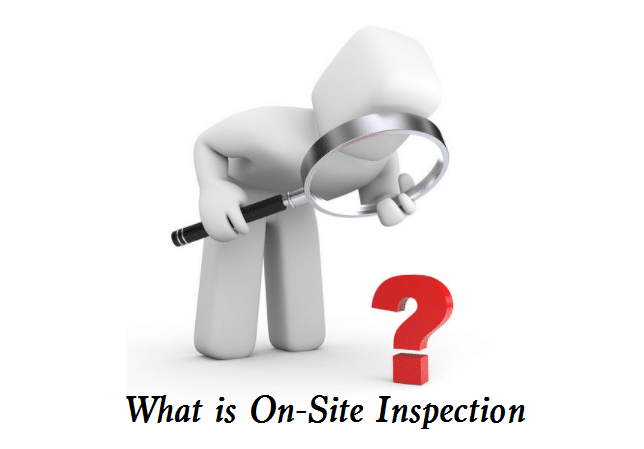
What is On-Site Inspection
On-site inspection refers to a physical examination of a location, typically in reference to industrial or construction sites, to assess compliance with regulations and standards, or to evaluate the progress and quality of work being performed.
Common Types of On-Site Inspection Building inspections (construction, safety, code compliance) Environmental inspections (pollution, waste management, land use) Health and safety inspections (workplace safety, fire safety, equipment inspection) Quality control inspections (manufacturing, product inspection) Food safety inspections (restaurant, food processing) Agricultural inspections (livestock, crop production)
How to Prepare for On-Site Inspection
To prepare for an on-site inspection, one can follow these steps: 1) Review the purpose and scope of the inspection – understand what is being inspected and what criteria will be used to assess it. 2) Gather relevant documentation – collect any permits, contracts, plans, reports, and other relevant documents. 3) Identify key personnel – determine who will be available to assist with the inspection and who has the necessary knowledge and authority to answer questions. 4) Schedule a pre-inspection meeting – to discuss the inspection process, expectations, and any special needs. 5) Review previous inspection reports – to identify any previous issues or non-conformities and determine how they were addressed. 6) Prepare the inspection area – ensure that the inspection area is accessible, safe, and free of any hazards. 7) Review the inspection checklist – to ensure that all relevant items will be covered during the inspection. 8) Plan for follow-up actions – identify any necessary corrective or preventative actions and plan for their implementation. 9) Preparing thoroughly for an on-site inspection can help to ensure that it is efficient, effective, and results in a positive outcome.
Difference Between On-Site and Off-Site Inspection
On-site inspection refers to an examination that takes place at the physical location of the item or activity being inspected. In contrast, off-site inspection refers to an examination that takes place at a location separate from the item or activity being inspected.
For example, a building inspection may take place on-site at the construction site, while an environmental impact assessment may take place off-site, with inspections being performed from satellite imagery or remote sensing. Off-site inspections are often less comprehensive than on-site inspections, but they can be useful for large-scale monitoring or assessment activities.
Operations and Standards
How top retail and hospitality brands execute programs and standards on time, in full, at every site
6 Ways to Save Time During Site Visits and Inspections
It’s no secret that site visits are incredibly important to your retail operations. Store audits and inspections enable you to evaluate programs and initiatives, ensure compliance, and even connect with teams on the ground.
However, they can also take time . Between audit preparations, travel time, inspecting stores, and following up, site visits can take anywhere from a couple of hours to a full day, possibly longer. Not to mention that when conducted inefficiently, site visit procedures are drawn out even more, resulting in wasted time and effort.
This is the last thing any business wants, which is why you should continuously strive to have more productive site visits that save you time and money.
1. Have a clear objective well before the site visit takes place
On time, in full, at every site execute programs and brand standards . as with pretty much any important task, having a clear objective is a must. before conducting a site visit, first identify your purpose and goals. specifically: what type of audit or inspection are you conducting some audits focus on merchandising , while others are centered around security , or health and safety . in certain cases, an inspection is focused on a specific campaign or initiative. what is the outcome you’d like to see identify the key outcomes that you’d like the audit to achieve. is it simply to see how a campaign is executed are you looking to improve a district’s compliance score whatever the case, make sure you know what “success” looks like before conducting your inspections. use the answers to the above questions to guide your inspections. identifying your objectives will help you determine which items to include in your checklists , what questions to ask, and what to prioritize . you’re less likely to get sidetracked, which means audits are conducted more efficiently. 2. be systematic and map out your visit ahead of time.
District managers often have to visit multiple stores, and traveling from one appointment to the next usually takes about 45 minutes (longer if the manager covers a large geographical area).
If you want to save time on inspections, it may be worth optimizing your schedule. Some pre-planning around which stores visit and in what order can go a long way. So, map out your visit in advance.
Using an actual map can be helpful here. Mark the points on the map that you need to visit, then identify which routes will save you the most time. Take into account factors such as time of day and traffic.
Google Maps has a useful feature that can estimate how long a trip will take based on the usual traffic conditions for a particular time of day. Simply enter your starting address and destination then indicate the date and time of the trip. Google will then display a travel time estimate, which you can use to plan your appointments.
Tools like Bindy offer a built-in map with a route feature between your stores to make it even easier.

It may also help to map out your route when you’re in the store. Which sections or departments will you inspect first? Where in the store are they located? Knowing these things ahead of time will allow you to hit the ground running once you’re on site.
3. Avoid Excel and Email
Excel spreadsheets are a step up from paper, but they can also be inefficient. While spreadsheets work well for recording and tabulating data, they’re not built for task management and collaboration — two tasks that are critical when conducting site visits.
You’re much better off digitizing your audits and inspections using a tool like Bindy , which lets you build checklists, schedule inspections, and manage tasks using an intuitive cloud-based platform.
Bindy streamlines site visits and inspections by eliminating manual work and double-entry. This means you can focus less on the tedious administrative tasks and devote more energy towards visiting stores and improving team performance.

4. Bring other team members into the same platform
Already using an audit solution? The next step is to bring other team members into the platform. This will make communication and collaboration a whole lot easier. Having everyone on a single platform keeps team members on the same page. Information is relayed quickly and accurately, and tasks are completed faster.
For instance, if corrective action is required after an audit, you can communicate with employees using the tool’s built-in action plan instead of having to do it via email or text. This benefit becomes even more pronounced when multiple team members are involved. Rather than tracking confusing email threads or sending multiple text messages, all communication takes place on a single platform so stakeholders are always in sync.
5. Repurpose information and materials from previous inspections
Don’t start your checklists or inspections from scratch. Have a template that you can repurpose to speed up audit preparations. For example, if you often conduct health and safety audits, create a template or form that’s pre-populated with commonly inspected items. Then when it’s time to prepare for your next inspection, you can pull up the template and customize it based on each store’s needs.
Use a similar approach for things like team communications. Instead of manually typing the same messages for things like corrective actions, use a form or template to save time.

6. Automate cumbersome tasks
Automate tedious tasks like capturing dates and times, notifying team members, or adding photos. This can all be done with a good audit platform. Bindy, for example, can automate corrective actions and populate the right date and time for recordkeeping. The system can also facilitate task follow-ups through automated notifications.
You can further streamline your processes by integrating your audit platform with other business solutions. Let’s say you want to eliminate manual calendar entries when scheduling audits. If your audit platform integrates with your calendar application, you can program it to automatically create a calendar entry whenever you schedule a new inspection.
Final words
Site visits can take time, but they don’t have to be inefficient or unproductive. With proper planning and the right tools, you can streamline your store inspections and audits, empower your team, and get more done in less time.
OTHER RETAIL Audit and Inspection RESOURCES
Refer to the Retail Audits and Inspections category for how-tos and best practices for retail audits and inspections.
About the author:

Francesca Nicasio is retail expert, B2B content strategist, and LinkedIn TopVoice. She writes about trends, tips, and best practices that enable retailers to increase sales and serve customers better. She’s also the author of Retail Survival of the Fittest , a free eBook to help retailers future-proof their stores.

- Click to share on LinkedIn (Opens in new window)
- Click to share on Facebook (Opens in new window)
- Click to share on Twitter (Opens in new window)
- Click to share on WhatsApp (Opens in new window)
- Click to email a link to a friend (Opens in new window)
One thought on “ 6 Ways to Save Time During Site Visits and Inspections ”
Great suggestions.
Leave a Reply Cancel reply
Discover more from Operations and Standards
Subscribe now to keep reading and get access to the full archive.
Type your email…
Continue reading
Chinese runner's win is revoked after investigation into Beijing Half Marathon

HONG KONG — The winner of Beijing’s half marathon , He Jie, and three African runners have had their results canceled after an investigation found that the three slowed down near the finish line allowing the Chinese athlete to finish first, organizers said Friday.
He had won the race held last Sunday in China’s capital in a time of 1:03:44, a second ahead of Ethiopian Dejene Hailu Bikila and Kenyans Robert Keter and Willy Mnangat, who tied for second place.
The organizing committee said in a statement that the three African runners “actively slowed down in the last 2 kilometers and as a result He Jie won the men’s championship.”
All trophies, medals and bonuses will be withdrawn and the athletes will be reported to the Chinese Athletics Association, it said.
The race operator, the Zhong’ao Lupao Beijing Sports Management company, will also be disqualified from hosting and operating the Beijing half marathon, the committee added.
Mnangat told the BBC that the trio ran as pacemakers and were not competing.
However, the committee said pacers would not have been allowed to participate as specially invited athletes without organizers’ approval.
The Zhong’ao Lupao Beijing Sports Management company said its partner Xiamen Xtep Investment, a unit of Hong Kong-listed Xtep, failed to note the relevant pacer information, which led to the organizing committee not being informed.
“Our company has unshirkable responsibility and would like to express our sincere apologies to all runners.” He has been sponsored by Xtep since 2021, according to its website.
Xtep said staff had made a mistake during the registration process and did not identify the pacers.
“We bear a great responsibility and fully accept the punishment decision made by the organizing committee,” Xtep said in a statement.
He was slightly behind the three African runners as they approached the end of the race, but they slowed down and waved the Chinese athlete ahead as they gestured toward the finish line. The four had run together throughout the race of just over 13 miles.
The finish drew widespread skepticism, with some social media users commenting that the result was “embarrassing” for He, a member of China’s marathon team and a national record holder.
Long-distance running races are increasingly popular in China but have a checkered history of cheating and poor organization. In Shenzhen’s 2018 half marathon, 258 participants were caught cheating, most of whom had taken shortcuts though some wore fake bibs and others were impostors.

IMAGES
COMMENTS
An engineering site visit checklist is critical for most projects. It's the reality check that keeps designs grounded in the real world. Site visits are the ultimate way to get up close and personal with a project and the client. You'll usually find yourself making site visits during these project stages: Project kickoff to grasp the work ...
A site visit analysis is a comprehensive report that summarizes the findings of a physical inspection of a potential development site. It includes information on the site's physical characteristics, location, surrounding area, demographic information, environmental impact, zoning regulations, traffic flow, and recommendations for development.
Field reports - also called site reports, inspection reports, construction field reports, site progress reports, or site visit reports - are drafted during regular site inspections and site meetings. They are used to document and share open items, items that were discussed, and the planning of the project. All tasks, actions, and deadlines ...
What to expect during a site visit. When conducting site observations, be prepared to: Review ongoing work: Assess the quality of completed work and identify any deviations from the approved plans. Address issues: Site visits allow you to identify and resolve any problems, whether they are related to design, materials, or workmanship. Coordinate with team members: Effective communication with ...
A site visit is a physical inspection of a construction site. It's an opportunity for the project team behind the build to see the work in progress and to identify any potential problems. They can be conducted by the project manager, the engineer, the architect or any other member of the project team. There are many benefits to conducting ...
A site inspection is a series of regular check-ups and verification processes to ensure safety standards and working conditions are met at a work site. The traditional method of conducting site inspections involves field visits and paper checklists. However, some organizations are now using digital tools to streamline the process.
A site visit is a visit to a construction site. Site visits are usually conducted by clients, architects, and other stakeholders before the project is complete. Site visits can be done in person or virtually using 3D models or video. Site visits are often used to review construction progress, identify potential risks and hazards, and confirm ...
For each activity, OUs must perform site visits to provide oversight over agreements/awards, inspect implementation progress and deliverables, verify monitoring data, and learn from implementation. While each Mission and the activity's context should inform the number and frequency of site visits, in general, Missions should conduct site ...
To Observe or To Inspect, That is the Question. Steve Gantner, RA, CSI, AGCMO, CCS, CCCA : Apr 7, 2021 10:32:12 AM. inspections Site Visits Observations Safety. Being the son of a brick mason, I was always fascinated with construction sites. Some may disagree, but as an Architect, one of best parts of the job was visiting the site to observe ...
Construction engineers spend much time on site visits, but visit effectiveness has not been explored and its effect on project performance is unclear. In this study, a checklist to improve the effectiveness of site visits was developed, based on site visit deficiencies and construction productivity factors found in the recent literature and the ...
Here's a breakdown of what should typically be included in a site visit report report: Project Reference: The construction project name and reference ID. Location: The exact address or co-ordinates of the construction site. Date of Site Visit: The specific date (s) when the visit was recorded. Prepared By: The name of the individual or team ...
The term inspection typically refers to the site visit with respect to the appraisal process. The inspection or site visit can have different steps and/or levels depending upon the scope of work of the engagement. Typical residential site visit types include: Interior and Exterior inspection Exterior only inspection No inspection (desktop products/reports) An
AIA Document A201™-1997, General Conditions of the Contract for Construction (A201), addresses site visit requirements: "4.2.2 The Architect . . . will visit the site at intervals appropriate to the stage of the Contractor's operations (1) to become generally familiar with and to keep the Owner informed about the progress and the quality ...
A site visit report serves as a crucial tool in the realm of project management, bridging the gap between on-ground realities and managerial oversight. Its primary purpose is to document firsthand observations, activities, and conditions of a specific site at a given time, offering a snapshot of the project's progress, challenges, and ...
Everything you should include on your site inspection checklist. As an experienced corporate emcee, I've been a part of plenty of site visits.Any great master of ceremonies knows that they need to be involved in all parts of the event planning process!. So, without further ado, let me give you a comprehensive breakdown of a well-rounded site inspection checklist.
March 2023. Health Center Program Site Visit Protocol (SVP) The Site Visit Protocol is a tool to assist the Health Resources and Services Administration (HRSA) perform its oversight of health centers. The SVP includes a standard and transparent methodology that aligns with the Health Center Program Compliance Manual.
Construction site visits are crucial for ensuring safety, compliance, and quality control on a project. These visits allow for inspections, assessments, and evaluations to be conducted, which can help identify and resolve any issues that may arise. By having a clear understanding of the project's progress, stakeholders can make informed decisions that will keep the project on track and within ...
Modern technology has made it far more efficient to capture, organise and track your site inspection checklists. In addition to speed, Site inspection software is also bringing new clarity and insight to site inspections by aggregating and processing all that checklist information quickly. These new efficiencies start at the source of the document.
A site inspection checklist helps event planners remember every little detail, no matter how small, when visiting a venue. It also helps to keep uniform records of site inspections as a future reference for both yourself and other team members. Organized and extremely detailed records like these are a huge asset to event planners, regardless of ...
Why conduct a site visit - The value of meaningful site inspections. November 28, 2017. Meetings and Business Events Industry, Sales and Service. When considering possible venues to host a meeting or conference, one of the best tools in the planner's toolbox for making the most informed decision are in-person site visits of the properties.
On-site inspection refers to an examination that takes place at the physical location of the item or activity being inspected. In contrast, off-site inspection refers to an examination that takes place at a location separate from the item or activity being inspected. For example, a building inspection may take place on-site at the construction ...
Following the site visit, a Classification Inspection Report is prepared describing the business operations. It includes an estimated count of employees and an estimate of the annual payroll by department. Typically, these reports are produced within 30 days of the site visit, and a copy of the Report is sent to the employer and the employer ...
2. Be systematic and map out your visit ahead of time. District managers often have to visit multiple stores, and traveling from one appointment to the next usually takes about 45 minutes (longer if the manager covers a large geographical area). If you want to save time on inspections, it may be worth optimizing your schedule.
Early morning joggers in Tel Aviv had differing reactions to reports of Israel's overnight attack on Iran. Some expressed concern while others felt Israeli action had been necessary.
Clark will pocket $338,056 over four years under her contract with the Indiana Fever. In contrast, last year's No. 1 NBA draft pick secured a $55 million four-year contract.
On Tuesday, "Lopez vs. Lopez" is premiering two back-to-back episodes. From left, George Lopez as George, Jaime Camil as Josué and Selenis Leyva as Rosie in the episode "Lopez vs. Raider Nation."
MUNICH, Germany — Two men have been arrested in Germany on suspicion of spying for Russia and collecting information about potential attack targets, including U.S. military facilities ...
An inquiry found that three African runners slowed down at the end of the race to allow He Jie, a member of China's marathon team and a national record holder, to finish first.